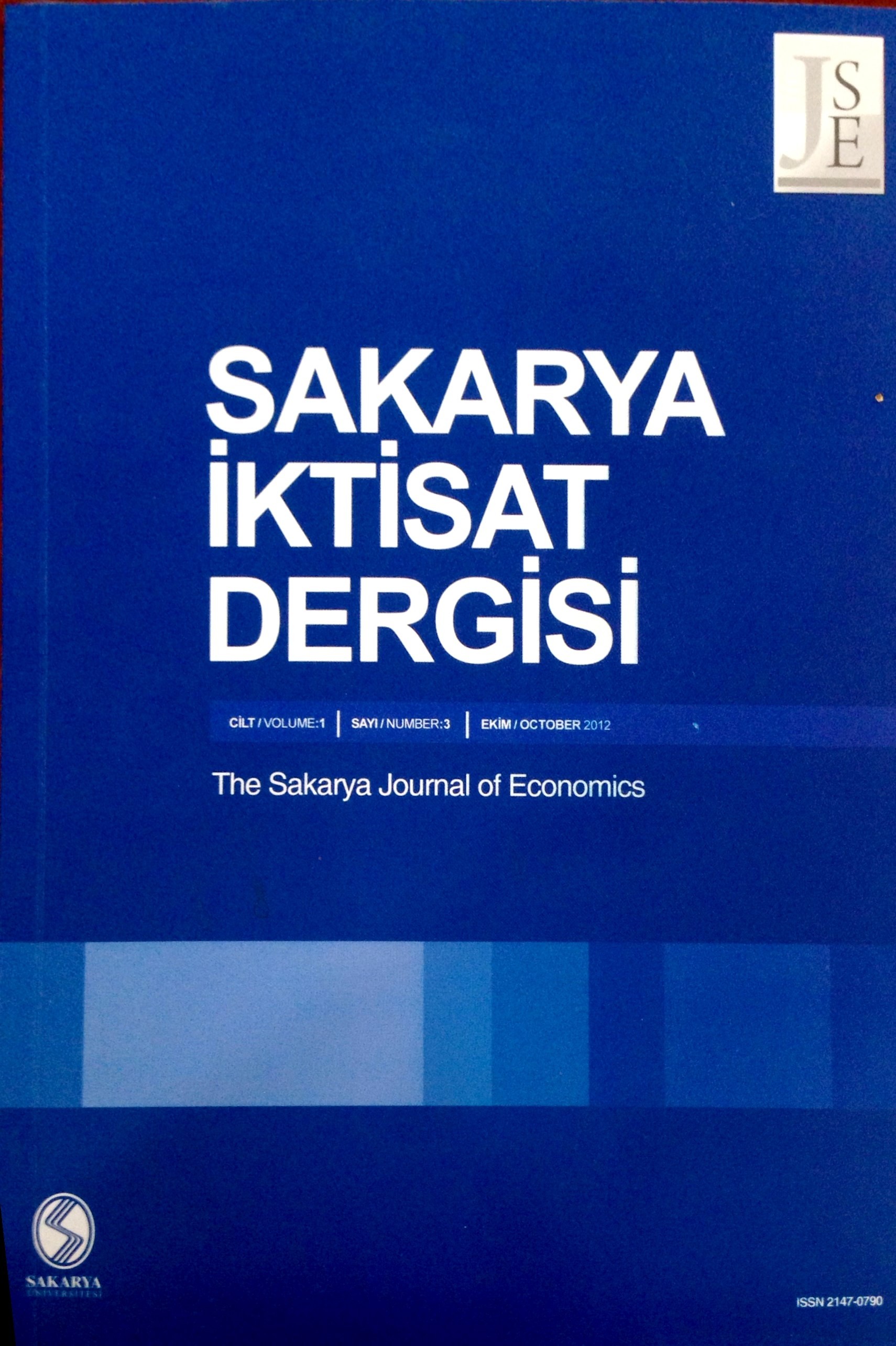MOĞOLİSTAN’DA DÖVİZ PİYASASININ KOŞULLU FARKLI VARYANS MODELLERİYLE TAHMİNİ
Bu çalışmada döviz kuru ve makro değişkenlerin temel kavramlarından hareketle, döviz
kuru değişimlerinin makro değişkenler üzerindeki etkileri incelenip, Moğolistan örneği
üzerinden belirlenen dönemler itibari ile döviz kurunda olan değişimler saptanmaya
çalışılmıştır. Döviz kuru ve diğer makro değişkenlerin aylık ve mevsimlik verileri ile
ARIMA, SARIMA ve SVAR modellerini analiz edilmektedir. Döviz kurunu hangi modelin
daha iyi tahmin edebileceğini ve gelecek aylar için döviz kurunun ne kadar olacağını
öngörülmektedir. Bunu yaparken, Fan chart tekniği kullanılarak döviz kurunun en az ve
en fazla kaç olduğunu göstermektedir. Ayrıca, günlük veriler için döviz kuru getirisini
ARCH ailesi modelleriyle belirlenmesi ve en uygun modelin bulunması amaçlanmıştır.
Anahtar Kelimeler:
Döviz kuru oynaklığı, Değişen Varyans, ARIMA, SARIMA, SVAR
FORECASTİNG OF EXCHANGE RATE MARKET IN MONGOLİA WİTH GENERALİZED AUTOREGRESSİVE CONDİTİONALLY HETEROSCEDASTİC MODELS
The object of this study
is to reveal analytically the effect of exchange rate volatility and
macroeconomic variable effects on the exchange rate in Mongolia. This study
forecasted the exchange rate by looking at the basic concepts of the exchange
rate and macro variables and to estimate the changes in the exchange rate. Exchange
rate and other macroeconomics variables in monthly and seasonaly are collected
and analyzed by ARIMA, SARIMA, and SVAR models. Moroever, the best result of
forecasts will be selected and given some month forecasts. Instead of forecast,
fan chart technique will be used to show the highest and the lowest prediction
of exchange rate. In addition, GARCH families model used to determine daily
data and found to be the most suitable model.
Keywords:
Exchange rate volatility, Heterocadasticity, ARIMA, SARIMA, SVAR,
___
- Bataa, E. (2016), Times series analysis, Ulanbator: Sod Publishers.
- Mankiw, G. (2013), Macroeconomics, New York: Worth Publishers.
- Kutlar, A. (2017), Uygulamalı Çok Eşitlikli Zaman Serileri, Kocaeli: Umuttepe Yayınları.
- Kutlar, A. (2017), EViews ile Uygulamalı Zaman Serileri, Kocaeli: Umuttepe Yayınları.
- Akıncılar, A. and Ş. Temiz. (2011). An Application Of Exchange Rate Forecasting In Turkey. Gazi University Journal of Science. 24(4): 817–828.
- Bollerslev, T. and D. Nelson. (1994). Arch Models. In Handbook Of Econometrıcs. Elsevier Science B.V.: Amsterdam. 4(1): 2961–3038.
- Boothe, P. and Glassman, D. (1987). Lessons for Exchange Rate Modelling. Oxford Economic Papers. 39(3): 443-457
- Dahiru, A. B. and O. A. Joseph. (2013). Exchange–Rates Volatility İn Nigeria: Application of Garch Models With Exogenous Break. CBN Journal of Applied Statistics. 4(1): 89-116.
- Etuk, E. H. (2013). The Fittıng Of A Sarima Model To Monthly Naıra-Euro Exchange Rates. Mathematical Theory and Modelling. 3(1): 1-8.
- Frankil, A. and K. Rose (1994). A Survey of Empirical Research on Nominal Exchange Rates. Natıonal Bureau Of Economıc Research.
- Güloğlu, B. ve A. Akman. (2007). Türkiye’de Döviz Kuru Oynaklığının SWARCH Yöntemi İle Analizi. Finans Politik & Ekonomik Yorumlar. 44(512): 43-51.
- Kadılar, C. ve M. Şimşek (2009). Forecastıng The Exchange Rate Serıes Wıth Ann: The Case Of Turkey. İstanbul Üniversitesi İktisat Fakültesi Ekonometri Ve İstatistik Dergisi. 9(1): 17-29.
- Kutlar, A. ve P. Torun. (2012). İMKB 100 Endeksi Günlük Getirileri İçin Uygun Genelleştirilmiş Farklı Varyans Modelinin Seçimi. Erciyes Üniversitesi İktisadi ve İdari Bilimler Fakültesi Dergisi. 42(1): 1-24.
- MacDonald, R. ve P. Mark (1993). The Monetary Model of the Exchange Rate: Long-run Relationships, Short-Run Dynamics and How to Beat a Random Walk. Journal of International Money and Finance. 13(1): 276-290.
- Meese, R. ve K. Rogoff (1985). Was It Real. The Exchange Rate—Interest Differential Relation, 1973—1984. NBER Working Paper.
- Mwase, N. (2006). An Empırıcal Investıgatıon Of The Exchange Rate Pass-Through To Inflatıon In Tanzanıa. IMF Working Paper. Obstfeld, M. and K. Rogoff (1994) Exchange Rate Dynamıcs Redux. Natıonal Bureau Of Economıc Research.
- Leigh, D. ve M. Rossi. (2002). Exchange Rate Pass-Through In Turkey. IMF Working Paper. 2(204): 2-18.
- Newaz, M. K. (2008). Comparing The Performance Of Time Series Models For Forecasting Exchange Rate. BRAC University Journal. 5(2): 55–65.
- Ramzan, S. ve F. M. Zahid. (2012). Modelıng And Forecastıng Exchange Rate Dynamıcs In Pakistan Using Arch Family Of Models. Electronic Journal of Applied Statistical Analysis. 5(1): 15–29.
- Robert F. Engle. (1982). Autoregressive Conditional Heteroscedasticity with Estimates of the Variance of United Kingdom Inflation, Econometrica, 50(1): 987-1007.
- Sarno, L. ve M. P. Taylor. (2002). Purchasing Power Parity and the Real Exchange Rate. IMF Staff Papers. 49(1): 65–105.
- http://1212.mn/stat.aspx?LIST_ID=976_L05 /20.01.2018
- https://mongolbank.mn/eng/liststatistic.aspx /12.01.2018
- https://sites.google.com/site/erdenebatba/Home/curriculum-vitae /01.02.2018
- http://www.en.nso.mn/content/242 /15.03.2018
- http://www.worldbank.org/en/country/mongolia /06.01.2018
- ISSN: 2147-0790
- Yayın Aralığı: Yılda 4 Sayı
- Başlangıç: 2012
- Yayıncı: Sakarya Üniversitesi
Sayıdaki Diğer Makaleler
TÜRK KAMU BÜTÇELEME SÜRECİNDE ARTTIRIMCILIK: 1985-2015 YILLARI ARASI EKONOMETRİK BİR ANALİZ
MOĞOLİSTAN’DA DÖVİZ PİYASASININ KOŞULLU FARKLI VARYANS MODELLERİYLE TAHMİNİ
Şakir SAKARYA, Nevzat ÇALIŞ, Mehmet Arif KAYACAN
OECD ÜLKELERİNDE PETROL FİYATLARININ EKONOMİK BÜYÜME ÜZERİNDEKİ ETKİSİ: PANEL NEDENSELLİK ÇALIŞMASI
